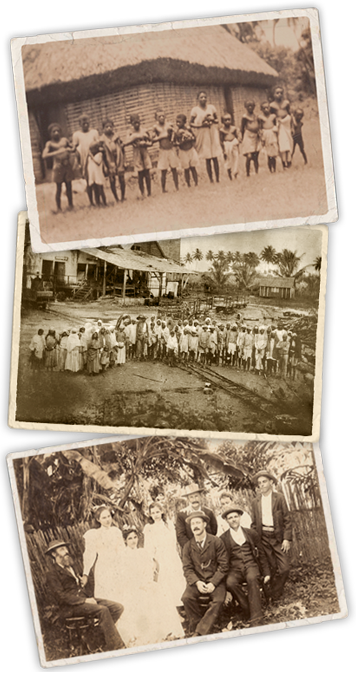

Pre-Colonial History
According to Fijian tradition, it was the God chiefs Lutunasobasoba and Degei who sailed a giant canoe from the ancient homeland across the sea to Fiji. Indeed, evidence shows that a group of the Lapita people, a seafaring group from eastern Indonesia or the Philippines, first arrived around 3,500 years ago. The descendants of these early people created a unique and highly developed culture long before the arrival of the first Europeans. Fijian social organization featured patrilineal clans, subclans, and lineages. Each clan occupied communal land with power embodied in a chief. There was often warfare between clans, with highly ritualized acts of violence including cannibalism. Fijians were known for such achievements as their great seagoing canoes (drua), large solid grass houses (bure), and their traditional dance theater (meke).
European explorers first arrived in Fiji accidentally, with the Dutchman Abel Tasman landing first in 1643, followed by the English ship captains James Cook in 1774 and William Bligh in 1789, who came after the famed mutiny on the Bounty. Shipwrecked sailors and runaway convicts were the first whites to actually live on the islands, and sandalwood traders and missionaries followed them in the 19th century.
Colonial Era
The arrival of Europeans caused disruption between the native Fijian confederacies, leading to bloody fighting and facilitating European influence. Ratu (chief) Cakobau gained some control of the islands mid-century, but continued unrest, coupled with his debt to the U.S. Government, ultimately led him along with other chiefs to sign a document of cession to Britain in 1874. Britain, however, was already bogged down in a long and brutal war with the Maoris in New Zealand and was reluctant to use force to annex Fiji. Instead, Sir Arthur Gordon, the first British Governor, decided to rule Fiji indirectly through the chiefs, while maintaining traditional institutions. He ordered that the communal lands, upon which the chieftain system was based, were not to be sold, only leased. Furthermore, he decided that Fijians could not be required to work on European plantations. However, as sugar planting increased, there became a massive shortage of labor. Gordon decided that indentured labor from India was the best solution to this problem, and from 1879 to 1916 large amount of Indian workers arrived in Fiji, later to stay on as independent farmers and businessmen. While Gordon’s system of rule did help preserve traditional Fijian culture, it also created economic and political differences between the races that would later be used to foment division.
Independence
In 1970 Fiji became a fully sovereign and independent nation within the Commonwealth of Nations. However, by 1987, a perception had developed among some ethnic Fijians that democratic rule had led to an Indo-Fijian dominance of government, and that year saw two successive military coups. The coups led to Fiji’s expulsion from the Commonwealth, and, in addition, led many Indo-Fijians to leave the country. A 1990 Constitution institutionalized ethnic Fijian dominance, but this was replaced by a new Constitution in 1997 supported by both ethnic Fijian and Indo-Fijian communities. However, this period of calm ended with the coup of 2000 led by Fijian nationalist George Speight, who with his gunmen, held Prime Minister Chaudhry and other members of parliament hostage in the House of Representatives in a standoff that dragged on for eight weeks. A settlement was negotiated, and Speight was eventually arrested, but tensions were flamed anew in 2006 when army commander Frank Bainimarama led a fourth coup d’état. In April 2009, the Fiji Court of Appeal ruled this coup illegal, but Present Iloilo abrogated the constitution and reappointed Bainimarama. In 2012, Bainimarama announced a process to create a new constitution. General elections were held in 2018 resulting in a decisive victory for Bainimarama’s ruling Fiji First party.
Links:
Fiji history and discovery at Pacific Cultural Center
Timeline linked to news articles at mapreport.com
Bibliography:
Possessing the Pacific:
Land, Settlers, & Indigenous People from Australia to Alaska
Banner, Stuart (2007).
Cambridge & London: Harvard University Press.
Law & Empire in the Pacific: Fiji and Hawai’i
Brenneis, Donald & Engle, Sally (2003). Santa Fe: School of American Research Press.
A History of Fiji
Derrick, R.A. (1946). Fiji Government Press.
Fiji Times: A History of Fiji
Gravelle, Kim (1979). Fiji Times & Herald Limited.
Race & Politics in Fiji
Norton, Robert (1977). NY: St. Martin’s Press
The Oxford History of the British Empire, Volumes II & III
Porter, Andrew (1999). Oxford & NY: Oxford University Press.
